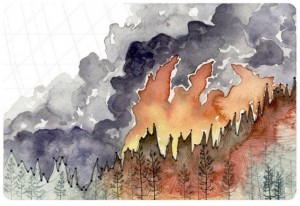10 February 2016
Turning climate data into art
Posted by Nanci Bompey
By Rebecca Fowler
This is part of a new series of posts that highlight the importance of Earth and space science data and its contributions to society. Posts in this series showcase data facilities and data scientists; explain how Earth and space science data is collected, managed and used; explore what this data tells us about the planet; and delve into the challenges and issues involved in managing and using data. This series is intended to demystify Earth and space science data, and share how this data shapes our understanding of the world.
Artist and scientist Jill Pelto turns climate data into watercolors, making visible the grim effects of climate change on forests, marine ecosystems and glaciers.

Large wildfires are happening more frequently and burning more area across the western U.S. in part due to rising temperatures. The global average temperature is shown between the flames and the forest.
Credit: Jill Pelto
Pelto is motivated to create these works by a desire to engage new and wider audiences in understanding climate science. “Most of the population doesn’t pay attention to the scientific community and research,” Pelto told Climate Central. “That’s the group I want to target.”
Science and art are a Pelto family affair. Jill’s father, Mauri Pelto, is a glaciologist who writes for AGU’s From a Glacier’s Perspective blog, for which Jill and her sister, artist Megan Pelto, designed the header.
See more of Jill Pelto’s work in this recent Climate Central story and on her website, www.jillpelto.com.
— Rebecca Fowler is a science communicator and the Director of Communications and Outreach at the Federation of Earth Science Information Partners (ESIP).


 GeoSpace is a blog on Earth and space science, managed by AGU’s Public Information staff. The blog features posts by AGU writers and guest contributors on all sorts of relevant science topics, but with a focus on new research and geo and space sciences-related stories that are currently in the news.
GeoSpace is a blog on Earth and space science, managed by AGU’s Public Information staff. The blog features posts by AGU writers and guest contributors on all sorts of relevant science topics, but with a focus on new research and geo and space sciences-related stories that are currently in the news.